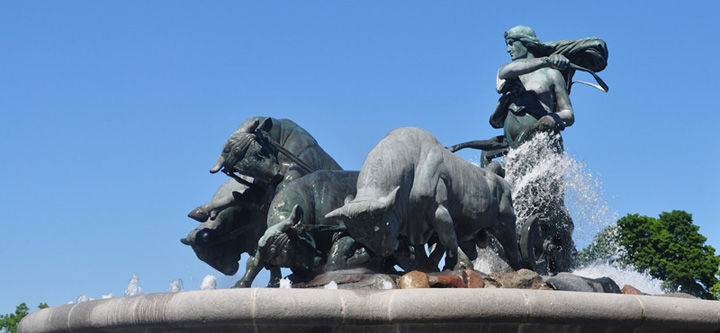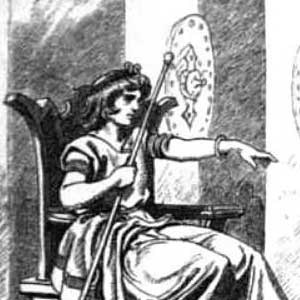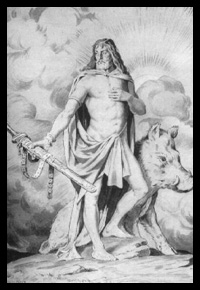According to Norse mythology, the beginning of life was fire and ice, with the existence of only two worlds: Muspelheim and Niflheim. When the warm air of Muspelheim hit the cold ice of Niflheim, the jötunn Ymir and the icy cow Audhumla were created. Ymir’s foot bred a son and a man and a woman emerged from his armpits, making Ymir the progenitor of the Jotun. Whilst Ymir slept, the intense heat from Muspelheim made him sweat, and he sweated out Surtr, a jötunn of fire. Later Ymir woke and drank Audhumbla’s milk. Whilst he drank, the cow Audhumbla licked on a salt stone. On the first day after this a man’s hair appeared on the stone, on the second day a head and on the third day an entire man emerged from the stone. His name was Búri and with an unknown jötunn female he fathered Bor, the father of the three gods Odin, Vili and Ve.
Tag: norse god Page 1 of 3

Gefion (“giver”) is an old-Scandinavian vegetation and fertility goddess, especially connected with the plough. She was considered the patron of virgins and the bringer of good luck and prosperity. Every girl who dies a virgin will become Her servant. She is married to King Skjold or Scyld a son of Odin, and lived in Leire, Denmark, where she had a sanctuary. The Swedish kings are supposed to be her descendants.
It is traditionally claimed that Gefion created the island of Zealand (“Sjaelland” in Danish) by ploughing the soil out of the central Swedish region with the help of her sons (four Swedish oxen), creating the great Swedish lakes in the process. In Copenhagen, Denmark, there is a large fountain showing Her in the process of ploughing.
Gefion could be another form of Frigga who is also known under that name.
 In Norse mythology, Forseti is the god of justice. He is the son of the god Balder and his mother is Nanna. He rules in the beautiful palace Glitnir with its pillars of red gold and its roof with inlaid silver, which serves as a court of justice and where all legal disputes are settled. See Myth 12 The Lay of Grimnir.
In Norse mythology, Forseti is the god of justice. He is the son of the god Balder and his mother is Nanna. He rules in the beautiful palace Glitnir with its pillars of red gold and its roof with inlaid silver, which serves as a court of justice and where all legal disputes are settled. See Myth 12 The Lay of Grimnir.
Although Forseti is one of the twelve leading gods, he is not featured significantly in any of the surviving myths.
He can be compared with the Teutonic god Fosite, who was worshipped on Helgoland a small Island in the North Sea.
The god of eloquence and poetry, and the patron of skalds (poets) in Norse mythology. He is regarded as a son of Odin and Frigga. Runes were carved on his tongue and he inspired poetry in humans by letting them drink from the mead of poetry. Bragi is married to Idun, the goddess of eternal youth. Oaths were sworn over the Bragarfull (“Cup of Bragi”), and drinks were taken from it in honor of a dead king. Before a king ascended the throne, he drank from such a cup.
Note: Originally, Bragi did not belong the pantheon of gods. He was a poet from the 9th century, Bragi Boddason. Poets from later centuries made him a god.
Little is known about Vali, except that he is a son of Odin and his giant mistress Rind. When Balder was killed unintentionally by his twin brother Hod, Vali was born to avenge his death.
“In the west Rind will give birth to Vali.
Merely one night old he will avenge the son of Odin.
He will not wash his hands, nor will he comb his hair
until Balder’s murderer burns at the stake.”
Aegir is the god of the sea in Norse mythology. He was both worshipped and feared by sailors, for they believed that Aegir would occasionally appear on the surface to take ships, men and cargo alike, with him to his hall at the bottom of the ocean. Sacrifices were made to appease him, particularly prisoners before setting sail.
His wife is the sea goddess Ran with whom he has nine daughters (the billow maidens), who wore white robes and veils. His two faithful servants are Eldir and Fimafeng. The latter was killed by the treacherous god Loki during a banquet the gods held at Aegir’s undersea hall near the island of Hler (or Hlesey). Aegir was known for the lavish entertainment he gave to the other gods.
Asgard, in Norse mythology, is the abode of the gods. Access to Asgard was possible only by crossing the bridge Bifrost (the rainbow).
Asgard was divided into 12 or more realms in which each principal god had his own luxurious mansion of gold or silver. The most important palace was Valhalla, the home of Odin, the chief of the gods.
Asgard, in Norse mythology, is one of the nine worlds and the homeland of the Aesir, the race of warrior gods. Located on the highest level of the Norse universe, it is surrounded by a high wall of closely fitted stone block
The walls surrounding Asgard were built by Blast (or Hrimthurs), who asked in payment the hand of Freyja plus the sun and the moon. Odin agreed providing the walls be complete in six months. Hrimthurs had a magic horse, named Svadilfari, who helped him in his work. To Odin’s (and the other gods, especially Freya’s) horror, with but a few days left, Blast was almost finished. Loki, the trickster, turned himself into a mare and beguiled the stallion Svadilfari away. The job was not completed in time and no payment was given.
Also found on this level are the worlds of Alfheim and Vanaheim as well as Valhalla, an immense hall where warriors slain in battle await the final conflict.
In the middle of Asgard lies the plain of Idavoll (or Ida) where the Aesir meet to decide important issues. There the gods assemble in the hall of Gladsheim and the goddesses in the hall of Vingolf.
The gods also meet daily at the Well of Urd, beneath the Asgard root of the ash tree Yggdrasil.
Valkyries, in Scandinavian mythology, are the warrior maidens who attended Odin, ruler of the gods. The Valkyries rode through the air in brilliant armor, directed battles, distributed death lots among the warriors, and conducted the souls of slain heroes to Valhalla, the great hall of Odin. Their leader was Brunhilde.
 Freyr is Freyja’s twin brother. He is the horned God of fertility, and has some similarities to the Celtic Cernunnos or Herne, although he is NOT the same being. He is known as King of the Alfs (elves). Both the Swedish and the English are said to be descendents of his. The Boar is his sacred symbol, which is both associated with war and with fertility. His golden boar, “Gullenbursti”, is supposed to represent the daybreak. He is also considered to be the God of Success, and is wedded to Gerda, the Jotun, for whom he had to yield up his mighty sword. At Ragnarok, he is said to fight with the horn of an elk (much more suited to his nature rather than a sword.)
Freyr is Freyja’s twin brother. He is the horned God of fertility, and has some similarities to the Celtic Cernunnos or Herne, although he is NOT the same being. He is known as King of the Alfs (elves). Both the Swedish and the English are said to be descendents of his. The Boar is his sacred symbol, which is both associated with war and with fertility. His golden boar, “Gullenbursti”, is supposed to represent the daybreak. He is also considered to be the God of Success, and is wedded to Gerda, the Jotun, for whom he had to yield up his mighty sword. At Ragnarok, he is said to fight with the horn of an elk (much more suited to his nature rather than a sword.)
